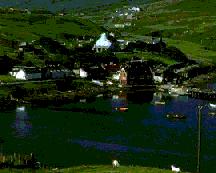Scottish Gaelic language
A form of Gaelic was brought to Scotland by Irish invaders about the 5th
century, where it replaced an older Brythonic language, also of Celtic
origin. Celtic tribes contacted there with Picts, a non-Indo-European nation
who inhabited the British Isles before Indo-Europeans came. Picts left
nothing in Scottish language except some geographical names and special
herbs' terms.
 By
the 15th century, with the accretion of Norse and English loanwords, the
Scottish branch differed significantly enough from the Irish to warrant
definition as a separate language. And nowadays these two languages, though
have very much in common in dictionary and grammar, are different.
By
the 15th century, with the accretion of Norse and English loanwords, the
Scottish branch differed significantly enough from the Irish to warrant
definition as a separate language. And nowadays these two languages, though
have very much in common in dictionary and grammar, are different.
The alphabet of Irish and Scottish Gaelic is
identical, consisting of 18 letters. Scottish Gaelic employs four cases
of nouns: nominative, genitive, dative, and vocative (Irish uses three).
Like Irish, the accent is ususally on the initial
syllable.
Scottish Gaelic exists in two main dialects, Northern and Southern,
roughly geographically determined by a line up the Firth of Lorne to the
town of Ballachulish and then across to the Grampian Mountains, which it
follows. The Southern dialect is more akin to Irish
than is the Northern, and is more inflected. The main difference is the
change of the Indo-European é sound, which is eu
in Northern dialect and ia in Southern. Thus, the
word for "grass" is pronounced feur in Northern and fiar
in Southern. But most of linguists define much more varieties of
the language each having its peculiarities. In fact, Scottish Gaelic is
very endangered by permanent expansion of English and Scots. Nowadays only
on the Shetland Isles people can be found who speaks only Gaelic. On the
continent, everyone understands English, and slowly loses his native tongue.
 By
the 15th century, with the accretion of Norse and English loanwords, the
Scottish branch differed significantly enough from the Irish to warrant
definition as a separate language. And nowadays these two languages, though
have very much in common in dictionary and grammar, are different.
By
the 15th century, with the accretion of Norse and English loanwords, the
Scottish branch differed significantly enough from the Irish to warrant
definition as a separate language. And nowadays these two languages, though
have very much in common in dictionary and grammar, are different.